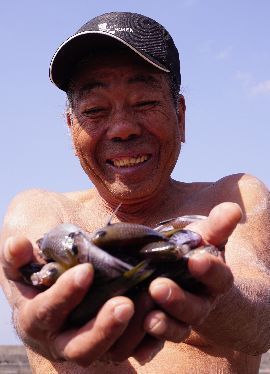“The eggs are Okinawa’s pollock roe!” 76 year-old fisherman’s solo pursuit of in-season Hichiguwa

Yoshikatsu Yamashiro drive fishing for hichiguwa at a depth of about ten meters (April 17th, Coast of Kunigami)
May 6, 2020 Ryukyu Shimpo
Text and Photography by Hiroyuki Takatsuji
“People used to call these the fisherman’s bonus, but no one spares them a second glance in this day and age,” says Yoshikatsu Yamashiro showing the fish he caught. Katsu, as his friends call him, is a suntanned 76 year-old fisherman in Kaganji, Kunigami. His catch is the pearl-spot chromis, called hichiguwa or hikaa in the local dialect. These fish are in-season in early summer when their bellies are full of eggs in preparation for spawning. “Their eggs are superb, like Okinawa’s pollock roe (mentaiko). If you eat the bones too, it’ll make you so healthy you can probably avoid the coronavirus!” He takes a big bite of one of the fish.

Yoshikatsu Yamashiro shows off handfuls of hichiguwa (April 17th, Hentona Fishing Port in Kunigami)
On April 17, Katsu went drive fishing off the coast of Kunigami. His target was the hichiguwa who live in the shallow waters around coral reefs and grow to be approximately eight centimeters long. It’s Katsu’s way to do everything himself, from herding the fish into the net to lifting the fish into the boat. He shoulders well-used handmade diving equipment and dives into the sea. About ten meters below the surface, where coral blankets the sea floor, a school of hichiguwa welcome him.
He pulls a large net along the base of the coral reef. The net took him eight years to make, from conception to completion. The 76 year-old fisherman swims the ocean effortlessly, his motions suggesting he has surpassed even a veteran fisherman and is close to becoming a fish. He closes the distance with the school of hichiguwa and blocks their path with a white pole called surukashi. “If you scare the fish, you won’t catch anything,” he explains. “The trick is to pretend to be their friend.” He herds them toward the net and in no time, the net is full of fish.
In the past, hichiguwa were as familiar to Okinawans as suku (newly hatched rabbitfish) as fish in-season from early spring to the rainy season. However, in recent years, changes in diet have seen fish from coastal waters around Okinawa vanish from dining tables and hichiguwa disappear from markets and grocery stores. Even auctioning them at the Kunigami Fishery Cooperative won’t get a decent price; almost no one drive fishes for hichiguwa now. “Before, as soon as you got them out of the water, people would be fighting for them,” Katsu says, “but now a lot of people don’t think you can eat them.”
People who heard about Katsu’s first fishing excursion in a while welcome him as he returns to shore. A woman who came from Kadena happily piles fish into a container and says, “they look delicious! I’m going to fry them!”
“I catch just enough for myself and friends, so we don’t forget how it was,” Katsu says, “I want everyone to remember the ocean’s blessings and our traditions that have been around since long ago.” Katsu smiles in the ocean breeze.
(English translation by T&CT and Ellen Huntley)
Previous Article:Teachers at Ohama Elementary School in Ishigagi write message for children in flowers on the sports ground, “It will certainly be soon”
Next Article:Photos & video: Okinawa enters rainy season
[Similar Articles]
- Dolphin fish dried in preparation for winter
- Smaller summer bonus of suku fish this year
- Big bluefin tuna caught off Kume Island coast
- 80-year-old Shinzato keeping traditional homestretch fishing for 50 years
- A super-sized haul of high-class spangled emperor fish known as taman brought into Toya Fishing Port in Yomitan, “It will be tasty any way you cook it”
 Webcam(Kokusai Street)
Webcam(Kokusai Street)


